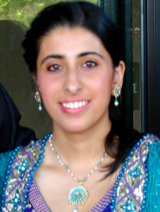"Dialogue does not mean everyone at the ‘table’ will agree with one another. Pluralism involves the commitment to being at the table—with one’s commitments."
—The Pluralism Project at Harvard University
 My 5-year-old Sikh-American brother came home from his local public school wearing a headband of paper feathers that adorned the top of his patka (small turban). He proudly showed me his ‘magical’ macaroni necklace, as he told me that he was dressed as a Native American. Struggling to react to this inherent irony, I was once again reminded of how I had been taunted as a Sikh-American in elementary school for being a ‘dot-Indian’ or a ‘feather-Indian’. Not only was his school perpetuating a stereotype, but was also blatantly misappropriating the culture of an indigenous community that has systematically and historically been bullied.
My 5-year-old Sikh-American brother came home from his local public school wearing a headband of paper feathers that adorned the top of his patka (small turban). He proudly showed me his ‘magical’ macaroni necklace, as he told me that he was dressed as a Native American. Struggling to react to this inherent irony, I was once again reminded of how I had been taunted as a Sikh-American in elementary school for being a ‘dot-Indian’ or a ‘feather-Indian’. Not only was his school perpetuating a stereotype, but was also blatantly misappropriating the culture of an indigenous community that has systematically and historically been bullied.
Before I could shove a copy of Howard Zinn’s, A People’s History of the United States, into my brother’s hands, I was struck by the inherent aesthetic and symbolic nature of the situation altogether. My brother who wore a patka—as is the case for most Sikh boys—was wearing religious headgear that has a history and culture behind it, similar to the religious and cultural symbols of other communities. If the school is teaching these kindergarteners that they could assume a cultural and ethnic identity by simply wearing those symbols without understanding the history, what is to stop them from donning a turban to be a “Sikh”?
I realized that schools are the first institutions that must become a model of pluralism, in order for pluralism to seep out into the rest of society. Students are placed in a social setting with other students from various backgrounds and must learn how to work efficiently with that diversity. It is simply not enough for American educational institutions to point out the diversity of their student body, the representation from various backgrounds, and pride themselves in the diversity of percentages alone.
Without ethnic and religious studies programs, these institutions will never be able to engage in true plurality, which would inevitably lead to actions based upon stereotypes and half-truths. Take bullying, for example. Preliminary results in a Bullying Prevention Survey have found that in the New York area more than half of Sikh children have been bullied and nearly 70 percent were Sikh males. (See survey here.)
These are three main points that I believe schools must be cognizant of when they create anti-bullying programs. Adapted from the Harvard University’s Pluralism Project.
- Pluralism is not diversity alone. We treat diversity and pluralism as if they are synonymous but in reality, diversity is plurality and pluralism is the active engagement of that plurality. Today, we see churches, mosques, and gurdwaras built to stand next to one another and represent the given religious diversity of our society. But pluralism is something that requires moving a step ahead of diversity. It is an achievement.
- Pluralism is not mere tolerance. Tolerance does not provide an obligation for Sikhs, Muslims, or Christians to know anything about each other. Tolerance alone does nothing to address historical patterns of division and violence that have fostered ignorant views of one another. Pluralism is the act of seeking an understanding among difference.
- Pluralism is based on active dialogue that encourages us to hold on to our deepest differences in relationship to one another. This active dialogue entails a relationship that requires both sides to speak and listen. They must be critical of one another and of themselves.

The events that transpired on Aug. 5 in Oak Creek, WI, serve as a stark reminder that despite having coexisted in America for more than 100 years, Sikhs are still not considered Americans. And it is this fact that should concern everyone.
The shooting shows us that we have allowed individuals such as shooter Wade Michael Page to steer the direction of America. Individuals like Page—a white supremacist—believe that diversity must be counteracted with violence, hate, and ethnic cleansing.
This is not the message that we want to send to the world, or to our children. Schools must practice active dialogue to ensure a safe environment for their students, and teach them to respect one another.
Amrit Kaur Sidhu is a UNITED SIKHS intern, and graduated from University of California, Santa Cruz in June 2012 with a degree in human biology and politics.
Comments
articulate
Very well written....